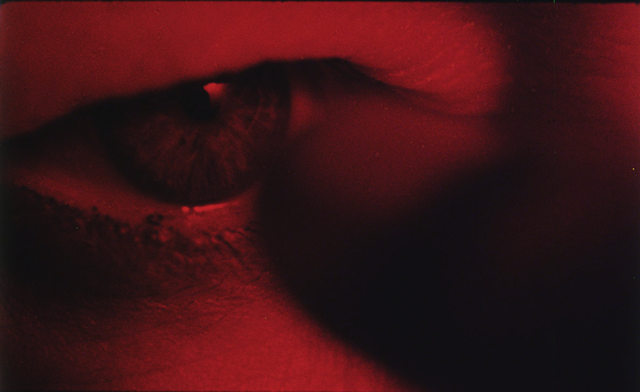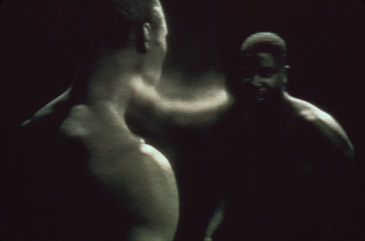Steve McQueen Retrospective May Change The Way You Look At The Art Institute
By Steven Pate in Arts & Entertainment on Oct 26, 2012 8:40PM

It is appropriate that walking into the Art Institute's Regenstein Hall to take in the Steve McQueen retrospective now on display is very likely to change the way you look at that museum's special exhibition space. Gone is the white-walled maze of partitions decked interminably with wall hangings, the configurations you may remember from blockbuster shows like Matisse: Radical Reinvention and Lichtenstein: A Retrospective. In its place is 18,000 square feet of darkened, cave-like and mostly open space lit almost entirely by the projected films, videos, slides and lightboxes it has been reconfigured to show off. This is a fitting testament to an artist with a genius for making the act of looking, and the space in which we do it, more interesting.
When the London-born artist first came to our awareness he was already an art-world star, having won the prestigious Turner Prize in 1999 and had major exhibitions across the globe. He has since represented the UK at the Venice Biennale and been appointed Commander of the Order of the British Empire. Yet it was the first of his two masterful feature films, Hunger (which garnered top prizes for best feature and best actor at the 2008 Chicago International Film festival along with a warehouse full of other festival-circuit hardware), that we knew first. His lauded follow-up, last year's Shame was if anything more impressive.
Eager to investigate the works on which he built his career, we found ourselves unsure if having our having first encountered his work in the longer format of the cineplex would leave these shorter, gallery-based works wanting. We should not have worried. The Art Institute's retrospective, the first comprehensive survey of his career, is a landmark showcase for the impressive body of work that backs up his glittering resume. Featuring 14 pieces going back beyond even his 1993 breakthrough Bear and covering the evolution of his practice all the way to End Credits, (debuting at the exhibition), Steve McQueen is a daring triumph the Art Institute.
 McQueen's film and video works are about the space in which they are encountered as much as the images they display, and the artist worked closely with Art Institute contemporary art curator James Rondeau to carefully situate them in a new space. The three faces of a gleaming, monumental triangle display three different projections on one side of the main room, while smaller works are spread through its other half, with the thrum of a 16mm projector the only thing masking a hushed silence. Sound baffling and angled hallways preserve the atmosphere of works that do have sound, like the immersively cinematic Western Deep, whose soundtrack is as intense as its shuddering portrait of existence in the world's deepest mine, a hallucinatory journey that is at turns frightening and visually arresting. The sense of isolation and confinement are enhanced by the closed-off in which it is shown. Other works, such as the silent Deadpan, an inspired riff on one of Buster Keaton's most famous stunts, get their own space as well.
McQueen's film and video works are about the space in which they are encountered as much as the images they display, and the artist worked closely with Art Institute contemporary art curator James Rondeau to carefully situate them in a new space. The three faces of a gleaming, monumental triangle display three different projections on one side of the main room, while smaller works are spread through its other half, with the thrum of a 16mm projector the only thing masking a hushed silence. Sound baffling and angled hallways preserve the atmosphere of works that do have sound, like the immersively cinematic Western Deep, whose soundtrack is as intense as its shuddering portrait of existence in the world's deepest mine, a hallucinatory journey that is at turns frightening and visually arresting. The sense of isolation and confinement are enhanced by the closed-off in which it is shown. Other works, such as the silent Deadpan, an inspired riff on one of Buster Keaton's most famous stunts, get their own space as well.
The unique spatial insistence of each of the 13 image-based works in this exhibition is something McQueen carried through into his feature films. For example, the subject of Hunger, IRA prisoner and hunger strike casualty Bobby Sands, is not introduced until after more than 20 minutes of footage establishes the the milieu and the atmosphere of the "Maze" Prison in which he died, creating narratively a space in which we can understand the figure himself. Likewise, the feeling of standing in the physical space of the compact room where the projection of Deadpan occupies an entire wall is essential to experiencing it.
These works are challenging, but far from obscure. Issues of identity, race and sexuality have received prominent discussion, and concerns about expression are never far away from an artist who quit NYU film school because they would not let him toss a camera through the air. While the confrontational bodies of Bear and the (literal) poke in the eye that is Charlotte take just a few minutes to unfold, their powerful imagery will linger long afterwards. McQueen doesn't want it to be too easy. As he told Adrian Searle in the Catalogue Raisonné which accompanies the exhibition (itself a true rarity for a film and video-based artist): "Sometimes you need to push it beyond what you think is the breaking point. You need to test it. OK, it goes up to ten, but does it go up to twelve? That's art really. Otherwise it would be everywhere."
Steve McQueen is open at the Art Institute, 111 South Michigan, through January 6, 2013.